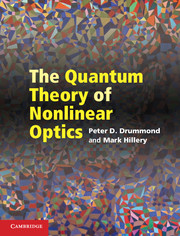Book contents
- Frontmatter
- Contents
- Preface
- Introduction
- 1 Classical nonlinear optics
- 2 Field quantization
- 3 Quantized fields in dielectric media
- 4 Microscopic description of media
- 5 Coherence and quantum dynamics in simple systems
- 6 Decoherence and reservoirs
- 7 Phase-space distributions
- 8 Single-mode devices
- 9 Degenerate parametric oscillator
- 10 Quantum field dynamics
- 11 Quantum propagation in fibers and waveguides
- 12 Quantum information
- List of symbols
- Index
- References
9 - Degenerate parametric oscillator
Published online by Cambridge University Press: 05 May 2014
- Frontmatter
- Contents
- Preface
- Introduction
- 1 Classical nonlinear optics
- 2 Field quantization
- 3 Quantized fields in dielectric media
- 4 Microscopic description of media
- 5 Coherence and quantum dynamics in simple systems
- 6 Decoherence and reservoirs
- 7 Phase-space distributions
- 8 Single-mode devices
- 9 Degenerate parametric oscillator
- 10 Quantum field dynamics
- 11 Quantum propagation in fibers and waveguides
- 12 Quantum information
- List of symbols
- Index
- References
Summary
The optical parametric oscillator is one of the most well-characterized devices in nonlinear optics, with many useful applications, especially as a frequency converter and as a wide-band amplifier. Novel discoveries made with these devices in the quantum domain include demonstrations of large amounts of both single-mode and two-mode squeezing, and, in the two-mode case, significant quantum intensity correlations between the two modes and quadrature correlations, which provided the first experimental demonstration of the original Einstein–Podolsky–Rosen (EPR) paradox. In this chapter, a systematic theory is developed of quantum fluctuations in the degenerate parametric oscillator.
The quantum statistical effects produced by the degenerate parametric amplifier and oscillator have been intensely studied. As we have seen, the amount of transient squeezing produced in an ideal lossless parametric amplifier was calculated using asymptotic methods by Crouch and Braunstein. It was found to scale inversely with the square root of the initial pump photon number. When the system is put into a cavity, and driving and dissipation are introduced, we find that the steady state of a driven degenerate parametric oscillator bifurcates. There is a single steady state at low driving strengths, but, as the driving field increases, a threshold value is reached and the single state splits and forms two stable states. Below the threshold, a linearized analysis of squeezing in the quantum quadratures is possible; while above this threshold, or critical point, the tunneling time between the two states due to quantum fluctuations can be calculated.
- Type
- Chapter
- Information
- The Quantum Theory of Nonlinear Optics , pp. 283 - 297Publisher: Cambridge University PressPrint publication year: 2014



